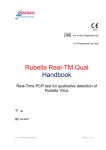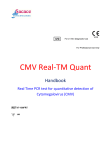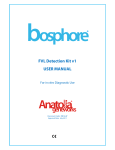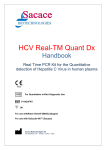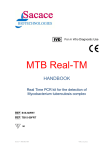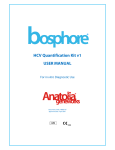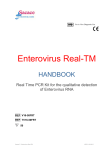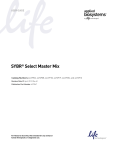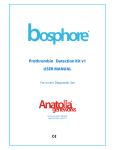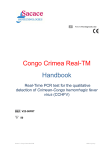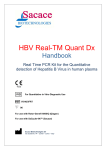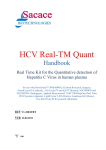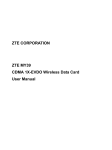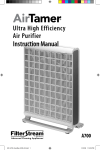Download HIV RNA Real TM 100 PCR NEW
Transcript
HIV Real-TM Quant Real-Time test for the quantitative detection of Human Immunodeficiency Virus (HIV) RNA for use with RotorGene™ 3000/6000/Q (Corbett Research, Qiagen), iQ iCycler™ and iQ5™ (Biorad), MX3000P® and MX3005P® (Stratagene), Applied Biosystems® 7300/7500/StepOne Real Time PCR Systems (Applera), LightCycler 2.0® (Roche), LineGene K® (Bioer), Eco Real Time PCR System® (Illumina) REF R-VM-100 FRT Sacace™ HIV Real-TM Quant April 18, 2011 NAME HIV Real-TM Quant INTRODUCTION HIV is a lentivirus (a member of the retrovirus family) differentiated on structural and antigenic properties into two virus types: HIV-1 and HIV-2. HIV-2 occurs considerably less often than HIV-1. In accordance with 1991 Nomenclature, there are three independent HIV-1 groups: М (main); О (outlier); N (non-V/non-O). In addition to this, there are the so-called “circulating recombinant forms (CRF)” viruses with a mosaic structure of the genome, elements of which are typical for representatives of various subtypes. Groups O and N are less widely spread and occur in African countries population. Group M includes 11 subtypes: А1, А2, B, C, D, F1, F2, G, H, J, K. Transmission ways of the virus are very important for the virus spread. HIV is transmitted by three ways: at heterosexual and homosexual sexual intercourse, parenteral with blood and blood products and vertically: from the infected mother to the child by an intrauterine way, during the child delivery or soon after the childbirth at breast feeding. One of the most effective current methods of direct HIV detection is specific amplification of nucleic acids in vitro by polymerase chain reaction (PCR). This method has a lot of advantages: • detection of virus DNA/RNA allows reducing the length of the “serological window; • PCR is an indispensable approach for HIV-diagnostics in children born from HIV-infected mothers; • determination of HIV RNA in the blood plasma (viral load) is an obligatory procedure to monitoring of the therapy effectiveness INTENDED USE kit HIV Real-TM Quant is a Real-Time test for the quantitative detection of Human Immunodeficiency Virus (HIV) and simultaneous detection of a HIV-specific Internal Control (IC), by dual color detection. PRINCIPLE OF ASSAY kit HIV Real-TM Quant is a Real-Time test for the quantitative detection of Human Immunodeficiency Virus in human plasma. HIV RNA is extracted from plasma, amplified using real time amplification and detected using fluorescent reporter dye probes specific for HIV or HIV IC. Internal Control (IC) serves as an amplification control for each individually processed specimen and to identify possible inhibition. IC is detected in a channel other than the HIV RNA. HIV Rec IC is a quantitative Internal Control (concentration reported in Data Card) and represents recombinant RNA-containing-structure which carried through all steps of analysis from nucleic acid extraction to PCR amplification-detection. The presence of quantitative HIV Rec IC allows not only to monitor the extraction procedure and to check possible PCR inhibition but also to verify possible losses of the RNA during extraction procedure thus enabling to calculate precisely the HIV viral load. Monitoring the fluorescence intensities during Real Time allows the detection and quantification of the accumulating product without having to re-open the reaction tube after the real time amplification. The kit will allow the quantification of 100 samples, including all the necessary reagents to generate the external standard curve of HIV and IC. To generate HIV and IC standard curve for quantification of the amplification products all calibrators should be used and defined as standards with specific concentrations. Sacace™ HIV Real-TM Quant April 18, 2011 MATERIALS PROVIDED Part N° 1 – “Controls” Part N° 2– “HIV Real-TM Quant”: RT Real Time kit; Part N° 1 – “Controls” • HIV Rec Pos1 Control, 4 x 0,01 ml; • HIV Rec Pos2 Control, 4 x 0,01 ml; • Negative Control, 4 x 0,5 ml; • HIV Rec IC (Internal Control), 4 x 0,13 ml. Part N° 2 – “HIV Real-TM Quant”: • DTT, 4 tubes. • RT-PCR-mix-1-TM HIV, 4 x 0,3 mL. • RT-PCR-mix-2-TM, 4 x 0,2 mL. • Hot Start TaqF Polymerase, 4 x 0,02 mL • M-MLV Revertase, 4 x 0,01 mL; • TE-buffer, 4 x 0,07 mL • Standard HIV1 o QS1 HIV, 4 x 0,025 mL; o QS2 HIV, 4 x 0,025 mL; o QS3 HIV, 4 x 0,025 mL; • Standard IC1 o QS1 IC, 4 x 0,025 mL; o QS2 IC, 4 x 0,025 mL; o QS3 IC, 4 x 0,025 mL; 1 Standards’ and controls’ concentrations are specific for every lot. MATERIALS REQUIRED BUT NOT PROVIDED • RNA isolation kit (see RNA isolation) • Desktop microcentrifuge for “eppendorf” type tubes • Vortex mixer • Disposable gloves, powderless • Biohazard waste container • Refrigerator, Freezer • Real Time Thermal cycler • Workstation • Pipettes (adjustable) • Sterile pipette tips with filters • Tube racks WARNINGS AND PRECAUTIONS 1. Wear disposable gloves, laboratory coats and eye protection when handling specimens and reagents. Thoroughly wash hands afterward. 2. Do not pipette by mouth. Do not eat, drink, smoke, apply cosmetics, or handle contact lenses in laboratory work areas. 3. Do not use a kit after its expiration date. Do not mix reagents from different kits. 4. Biosafety Level 2 should be used for materials that contain or are suspected of containing infectious agents. 5. Specimens and controls should be prepared in a laminar flow hood. 6. Heparin has been shown to inhibit reaction. Use of heparinized specimens is not recommended. 7. Avoid repeated thawing and freezing of the reagents, this may reduce the sensitivity of the test. 8. Once the reagents have been thawed, vortex and centrifuge briefly the tubes. 9. Prepare quickly the Reaction mix on ice or in the cooling block. 10. Specimens may be infectious. Use Universal Precautions when performing the assay. 11. Clean and disinfect all spills of specimens or reagents using a disinfectant such as 0,5% sodium hypochlorite, or other suitable disinfectant. Follow by wiping down the surface with 70% ethanol. 12. Avoid contact of specimens and reagents with the skin, eyes and mucous membranes. If these solutions come into contact, rinse immediately with water and seek medical advice immediately. 13. Material Safety Data Sheets (MSDS) are available on request. 14. Use of this product should be limited to personnel trained in the techniques of DNA amplification. 15. Workflow in the laboratory must proceed in a uni-directional manner, beginning in the Extraction Area and moving to the Amplification Area. Do not return samples, equipment and reagents in the area where you performed previous step. Personnel should be using proper anti-contamination safeguards when moving between areas. Sacace™ HIV Real-TM Quant April 18, 2011 STORAGE INSTRUCTIONS Part N° 1 – “Controls” must be stored at 2-8°C. Part N° 2 – “HIV Real-TM Quant” must be stored at -20°C. The kit can be shipped at 2-8°C for 3-4 days but should be stored at 2-8°C and -20°C immediately on receipt STABILITY HIV Real-TM Quant Test is stable up to the expiration date indicated on the kit label. The product will maintain performance through the control date printed on the label. Exposure to light, heat or humidity may affect the shelf life of some of the kit components and should be avoided. Repeated thawing and freezing of these reagents should be avoided, as this may reduce the sensitivity. Components stored under conditions other than those stated on the labels may not perform properly and may adversely affect the assay results. SAMPLE COLLECTION, STORAGE AND TRANSPORT Note: Handle all specimens as if they are potentially infectious agents. 1. 2. 3. 4. 5. 6. 7. EDTA tubes may be used with the HIV Real-TM Quant. Follow sample tube manufacturer’s instructions. Whole blood collected in EDTA should be separated into plasma and cellular components by centrifugation at 800-1600 x g for 20 min within six hours. The isolated plasma has to be transferred into a sterile polypropylene tube. Plasma may be stored at 2-8°C for an additional 3 days. Alternatively, plasma may be stored at -18°C for up to one month or 1 year when stored at -70°C. Do not freeze whole blood. Specimens anti-coagulated with heparin are unsuitable for this test. Thaw frozen specimens at room temperature before using. Whole blood must be transported at 2-25°C and processed within 6 hours of collection. Plasma may be transported at 2-8°C or frozen. Transportation of clinical specimens must comply with country, federal, state and local regulations for the transport of etiologic agents. RNA ISOLATION The following isolation kits are recommended: ⇒ Ribo Virus 100– spin column extraction kit (Sacace, REF K-2-C/100) ⇒ Ribo-Sorb-100 (Sacace, REF K-2-1/100) ⇒ Magno-Sorb – Magnetic RNA/DNA extraction kit (Sacace REF K-2-16/1000) Please carry out the RNA extraction according to the manufacturer’s instructions. Add 5 µl of Internal Control during the RNA isolation procedure directly to the sample/lysis mixture (see Internal Control) INTERNAL CONTROL (HIV Rec IC) HIV Rec IC is a quantitative Internal Control (concentration reported in Data Card) and represents recombinant RNA-containing-structure which carried through all steps of analysis from nucleic acid extraction to PCR amplification-detection. The presence of quantitative HIV Rec IC allows not only to monitor the extraction procedure and to check possible PCR inhibition but also to verify possible losses of the RNA during extraction procedure thus enabling to calculate precisely the HIV viral load. Protocol: 1. Thaw one set of reagents, vortex and centrifuge briefly the tubes. 2. Prepare 0,2 µl tubes or PCR plate. 3. Prepare Reaction Mix: add into the tube with DTT 300 µl of RT-PCR-mix-1 HIV, 200 µl of RT-PCR-mix-2, 20 µl of Hot Start TaqF Polymerase and 7,5 µl of M-MLV Revertase. Vortex thoroughly and centrifuge briefly. (If it is necessary to test less than 25 samples add into the tube with DTT, 300 µl of RT-PCR-mix-1, 200 µl of RT-PCR-mix-2 and vortex for at least 5-10 seconds. This mix is stable for 1 month at -20°C. Add for each sample (N) in the new sterile tube 12,5*N µl of mix, 0,5 *N µl of TaqF Polymerase and 0,25*N µl of M-MLV.) 4. Add 12,5 µl of Reaction Mix into each tube. 5. Add 12,5 µl of extracted RNA sample to the appropriate tube with Reaction Mix and mix by pipetting If the Ribo-Sorb isolation kit is used as a RNA extraction kit, re-centrifuge all the tubes with extracted RNA for 2 min at maximum speed (12000-16000 g) and take carefully supernatant. N.B. don’t disturb the pellet, sorbent inhibit reaction! 6. Prepare for each run 6 standards and 1 negative control *: • add 12,5 µl of Quantitation Standards HIV (QS1 HIV, QS2 HIV, QS3 HIV) into 3 labeled tubes; • add 12,5 µl of Quantitation Standards IC (QS1 IC, QS2 IC, QS3 IC) into 3 labeled tubes; • add 12,5 µl of TE-buffer to the tube labeled Negative Control; Sacace™ HIV Real-TM Quant April 18, 2011 PROTOCOL DATA ANALYSIS: RotorGene™ 3000/6000/Q (Corbett Reasearch, Qiagen) 1. 2. 3. Close tubes and transfer them into the carousel of the Rotor-Gene 3000/6000/Q. Click New in the main menu. Select New Run and Dual Labeled Probe. Click New. 4. Program Rotor-Gene 2000/3000/6000 as follows: Ø Select Rotor Type 36-Well Rotor and No Domed 0,2 ml Tubes Ø Reaction Volume (µl): 25 Ø Temperature Profile: 1. Hold 50 оC – 30 min 2. Denature 95 оС - 15 min 3. Cycling 95 оС - 20 s 52 оС - 30 s 72 °С – 30 s Cycle repeats – 5 times 4. Cycling 95 °С - 20 s 55 °С - 30 s* 72 °С – 30 s Cycle repeats – 40 times 5. Fluorescence is measured at 55°C on FAM (Green) and JOE (Yellow) channels 6. In the window New Run Wizard click Calibrate (Gain Optimisation…for Rotor-Gene 6000). In the new window Channel Setting select channels Joe (Yellow) and Fam (Green). Indicate Tube Position 1, Min Reading 5, Max Reading 10 and select function Perform calibration (Optimization) before 1st Acquisition. Click Close button. 7. Select Next and click Start run Program position of the tubes in the carousel of the Rotor-Gene 2000/3000/6000 and enter the concentrations of the Quantitative Standards (reported on the HIV Real-TM Quant Data Card) in order to generate Standard curve. Results Analysis IC amplification analysis (channel Cycling A.Fam/Green) 1. Press Analysis then select Quantitation →Cycling A.Fam (Cycling A.Green ) → Show 2. Turn off the automatic option Threshold. 3. Press buttons Dynamic Tube, Slope Correct. Select Threshold: 0,03 4. In the table of results (Quantitation Results) appear the values of Ct (Threshold cycle) which should be ≤ 28. If the Ct value of the specimen is absent or higher than 28 a retesting of the sample is required. 5. In the menu window Quantitation Results column Calculation concentration appear values of IC cDNA copies/specimen. 6. The Coefficient correlation value R in the “Standard Curve” window should be ≥ 0,9 (if < 0,9 a retesting of all samples is required). HIV amplification analysis (channel Cycling A.Joe/Yellow) 1. Press Analysis then select Quantitation →Cycling A.Joe (Cycling A.Yellow)→ Show 2. Turn off the automatic option Threshold. 3. Press buttons Dynamic Tube, Slope Correct 4. In the table of results (Quantitation Analisis) select More settings for VI version of software or Quant. Settings for V version. Set NTC Threshold to 5%. Select Threshold: 0,03 5. In the table of results (Quantitation Analisis) appear the values of Ct (Threshold cycle). 6. In the menu window Quantitation Results appear values of HIV cDNA copies/specimen. If the Ct value of the specimen is higher than 40 a retesting of the sample is required. 7. The Coefficient correlation value R in “Standard Curve” window should be ≥ 0,9 (if < 0,9 a retesting of all samples is required). Sacace™ HIV Real-TM Quant April 18, 2011 iQ iCycler™ and iQ5™ (Biorad): ● Select in the main menu “Define Protocols” and click “Create a new protocol”. Set the following parameters: Cycle Repeats Step Dwell Time Set Point 1 1 1 30:00 50.0 2 1 1 15:00 95.0 3 1 00:20 95.0 5 2 00 :30 52.0 3 00 :30 72.0 4 1 00:20 95.0 42 2 00:40 55.0* 3 00:30 72.0 Fluorescence is measured at 55°C on FAM and JOE (HEX) channels ● ● ● ● ● ● ● Double click in the Protocol File Name text box and enter a new name for the protocol. Click “Save this protocol”. Select “Edit Plate Setup” to create the “plate” for samples and standards. In the new window click “Samples: Whole Plate loading”. Use icon “Unknown” for the wells that contain samples, icon “Standard” to identify wells that contain calibrators and “-Control” for Negative Control. Give a name for the samples in the “Sample Identifier” box. Enter any name for the standard in the Identifier box and enter the concentrations of the Quantitative Standards (reported on the HIV TM iQ Quant Data Card) in the “Standard Quantity” box. Click “Select and Load Fluorophores” in the “Edit Plate Setup” window and select Joe-530 and FAM-490. Double click in the Plate Setup Filename field at the top left of the window and enter a name for the plate setup file and click “Save this plate setup”. Click “Run with selected protocol”. Indicate reaction volume, 25 µl. Select “PCR Quantification Melt Curve” and “Experimental Plate”. Click “Begin Run” Sacace™ HIV Real-TM Quant April 18, 2011 DATA ANALYSIS ● Click “View Post-Run Data” in the top right of Library module. Select the name of Data file and click “Analyze Data”. ● Select “PCR Quantification” window of Data Analysis module and set icon JOE-530 in “Select a Reporter”. Click “User Defined” near the displayed threshold position and enter 50 into the “Threshold Position” field. Click “Recalculate Threshold Cycles”. Make sure that in the window “Select Analysis Mode” is selected “PCR Baseline Subtracted Curve Fit”. Select “PCR Standard Curve” tab. In the new window appear curves and values of HIV cDNA. ● Make a similar procedure for FAM-490 channel. Click “User Defined” near the displayed threshold position and enter 30 into the “Threshold Position” field. Click “Recalculate Threshold Cycles”. Make certain that in the window “Select Analysis Mode” is selected “PCR Baseline Subtracted Curve Fit”. ● ● ● Select “PCR Standard Curve” tab. In the new window appear curves and values of IC cDNA. In results table “PCR Standard Curve” appear Ct (Threshold cycle) values which should be ≤ 28: if value is more than 28 a retesting of sample is required. The Coefficient correlation value R in “Standard Curve” window should be ≥ 0,9 (if < 0,9 a retesting of all samples is required). If the Ct value of the specimen is higher than 40 a retesting of the sample is required. Sacace™ HIV Real-TM Quant April 18, 2011 Applied Biosystems® 7300/7500/StepOne Real Time PCR Systems (Applera) 1. Select in the main menu the option “New Experiment” (Advanced Setup), insert experiment details. Select your Instrument Type (7500 / 7500 fast/StepOne/StepOne Plus), Quantitation – Standard curve, Taqman Reagents, Standard ramp speed (DO NOT select Fast RampSpeed). Note: when using StepOne software, be sure to click New Experiment – Advanced Setup 2. 3. Click , add two targets: one for HIV (Reporter Joe) and the other one for Internal Control (Reporter Fam); select Quencher – None for both targets. Click Add new samples multiple times and enter name for all samples, controls and standards 4. Click Assign target and Samples tab, associate samples ( ) and standards ( select None as passive reference dye as shown in the following pictures: )with the two targets and 5. Double-click on each standard well (a new small window will appear) and enter both for HCV, HBV or HIV and Internal control the corresponding concentration in the Quantity field as indicated in the Data Card: 6. Click on , insert Reaction volume (25 µl): HIV Real-TM Quant Stage 1 Profile 50°C – 30:00 Reps 1 2 95°C – 15:00 1 3 95°C – 0:20 52°C – 0:30 72°C – 0:30 95°C – 0:20 55°C – 0:40* 72°C – 0:30 5 4 7. Click to begin PCR reaction. 8. 9. After the run is complete, select all samples and standards and click Deselect Use default settings, Automatic threshold and automatic baseline; suggested values are*: Ct setting for HIV Ct setting for Internal Control * for StepOne instrument recommended Threshold values are: Joe (HIV) = 1,000, Fam (IC) = 2,000. NOTE: please slightly adapt suggested values according to your result curves Sacace™ HIV Real-TM Quant April 18, 2011 40 10. Click 11. Select all samples and standards, click View well table and then Click File -> Export, select Results only. 12. Click Customize Export and sort samples by reporter, as indicated in the above image. Then click to export results in a file. 13. Using the exported file, calculate results pasting data from the Sample and the Quantity columns in the provided HIV Quant Result Calculation sheet. Sacace™ HIV Real-TM Quant April 18, 2011 LightCycler 2.0® (Roche) 1. Select “New” , “LightCycler Experiment”, Click and insert as follows: • Max. Seek Pos. indicates the number of samples used in the experiment • Choose Instrument Type according to your instrument • Choose capillary Size according to your capillaries (we suggest to select 20 µl and use 30 µl polycarbonate capillaries) 2. Program the thermalcycling as follows: HIV Real TM Quant Stage 1 2 3 4 Profile 50°C – 30:00 95°C – 15:00 95°C – 0:20 52°C – 0:30 72°C – 0:30 95°C – 0:20 55°C – 0:40* 72°C – 0:30 Reps 1 1 5 40 *Acquisition mode - Single 3. Click and insert sample names; then select Absolute Quantification from Analysis Type and select 530, 560 in Selected Channels section: 4. Insert target Name, Sample Type (Standard for standards, Unknown for all other samples), and insert sample concentration values as reported in the Data Card. 5. Click 6. After Run is completed click button and select Absolute quantification. Select Method (Auto) , Standard Curve (In Run). Ct values and calculated results will appear, for the selected channel, under the CP and Concentration column in the Absolute Quantification table. Calculate results manually using the usual formula as indicated in the User Manual of the kit. 7. to start PCR reaction. At first usage the operator must perform a color compensation experiment asking Sacace for the detailed instructions. Sacace™ HIV Real-TM Quant April 18, 2011 Eco Real Time PCR System (Illumina®) 1. Open Eco software, click and under Experiment Type select as starting material for HIV Real-TM Quant. 2. Under Quantification Method select 3. Click , , select RNA , and insert experiment name. Click , set up two assays: one for HIV (Reporter HEX) and the other one for Internal Control (Reporter Fam); select Quencher – Non fluorescent for both targets. Click 4. 5. Click and enter name for all samples, controls and standards. Click Associate samples and standards with the two previously designed assays following this procedure: select the well, select Unknown for samples and Standard for standards and to assign the corresponding assay click the white circle of the HCV and Internal control assays (the circle will become colored): for each well both Assays must be assigned. 6. Click and in the Set Up Standards box insert each value reported in the DataCard (click Enter after inserting each value) both for HIV assay and Internal control assay; then associate concentration values to the corresponding well. In the end it should look like above: 7. Click on , and program the instrument as follows (reaction volume is 20 µl**): HIV Real TM Quant Stage 1 2 3 4 Profile 50°C – 30:00 95°C – 15:00 95°C – 0:20 52°C – 0:30 72°C – 0:30 95°C – 0:20 55°C – 0:40* 72°C – 0:30 Reps 1 1 5 40 8. Click Start Run 9. After the run is complete click 10. Click ** Add 10 µl of Reaction Mix into each tube. Add 10 µl of extracted RNA sample or quantitative standards to the appropriate tube with Reaction Mix to begin PCR reaction. then click tab to interpret the results. to Export the samples, in the Export Options select Results Table 11. Using the exported file, calculate results pasting data from the Sample Name and the Quantity columns in the provided HIV Quant Result Calculation sheet. Sacace™ HIV Real-TM Quant April 18, 2011 LineGene K® (Bioer) Open LineGeneK Software. Click File -> New. In the Setup Programs tab, Insert User Name and Test Name. Click Dyes button and select FAM, JOE. Insert the correct liquid quantity (25 µl). Click the button 4 times and then program the 4 thermalcycling steps as in the following table: Program Cycles Target Temp.(C) Incubation Time Temp. Transition Rate(C/s) Sample Mode Cycle/Temp.1 1 50 0:30:00 04 None Cycle/Temp.2 1 95 0:15:00 04 None 95 0:00:20 04 None 52 0:00:30 04 None 72 0:00:30 04 None 95 0:00:20 04 None 55 0:00:40 04 Single Cycle/Temp.3 Cycle/Temp.4 5 42 72 0:00:30 04 None On the second phase (55.0 °C) of step 4 select “Single” on the Sample Mode column to collect fluorescence data, as shown in this picture: Click the menu System Parameters (P) -> Gain Setup (G). Select Auto Gain box and click OK (see picture below for Gain Setup details). Click the menu Sample Information (S) -> Sample Group Setup…(R). Select at least 2 groups. Click OK. Click the menu Sample Information (S) -> Sample Data…(S). Insert Sample name, Property (U for unknown samples and negative PCR control, S for Standards) and insert standard concentration reported in Data Card. Click or click File -> Run Programs (R) to Run the PCR program. Sacace™ HIV Real-TM Quant April 18, 2011 Results Analysis - FAM In the Quantitative Analysis tab, select from the menu Dyes(D) -> FAM(F). Select standard Concentration boxes (left mouse click+CTRL) for Internal Control (see picture below). Then do in this order: 1) Under Analysis Method select Fit Points. 2) Under Analysis Step Click Zero Adjust, select Auto and then click OK. Then click Baseline 3) Select 2 points and set the base line (drag and drop the red baseline) as low as possible but above the noise of each sample (usually 10-12) 4) Under Analysis Step clic Analysis. Calculated copies/reaction of Internal Control and Ct Results should appear in the Ct and the “Calculated Concentration” column respectively. Results Analysis - Joe In the Quantitative Analysis tab, select from the menu Dyes(D) -> Joe(F). Select standard Concentration boxes (left mouse click+CTRL) for HIV. Then do in this order: 1) Under Analysis Method select Fit Points. 2) Under Analysis Step Click Zero Adjust, select Auto and then click OK. Then click Baseline 3) Select 2 points and set the base line (drag and drop the red baseline) as low as possible but above the noise of each sample (usually 10-15) 4) Under Analysis Step clic Analysis. Calculated copies/reaction of HIV and Ct Results should appear in the “Ct” and the “Calculated Concentration” column respectively. Internal control – FAM Sacace™ HIV Real-TM Quant HIV RNA – Joe April 18, 2011 RESULTS INTERPRETATION For each control and patient specimen, calculate the concentration of HIV RNA using the following formula: HIV DNA copies/specimen x coefficient* = copies HIV/mL IC DNA copies/specimen *coefficient is specific for each lot and reported in the HIV Real-TM Quant Data Card provided in the kit. Results may by calculated also using “HIV Quant Result Calculation sheet” provided with the kit HIV Real-TM Quant is linear from 25 to 5 x 106 copies/mL. Test results greater than 5.000.000 copies/mL are above the upper limit of quantitation of the test and should be reported as “greater than 5.000.000 copies/mL”. If quantitation results are desired for such samples, the specimen should be diluted 1:10 with negative serum and retested. Test results less than 25 copies/mL are below the lower limit of quantitation of the test and should be reported as “less than 25 copies/mL”. PERFORMANCE CHARACTERISTICS Analytical specificity The analytical specificity of the primers and probes was validated with negative samples. They did not generate any signal with the specific HIV primers and probes. The specificity of the kit HIV Real-TM Quant was 100%. The potential cross-reactivity of the kit HIV Real-TM Quant was tested against the group control. It was not observed any cross-reactivity with other pathogens. Analytical sensitivity The kit HIV Real-TM Quant allows to detect HIV RNA in 100% of the tests with a sensitivity of not less than 25 copies/ml . The detection was carried out on the control standard and its dilutions by negative plasma using the “Magno-Sorb” extraction kit (Sacace REF K-2-16/1000) and RotorGene 6000. Target region: pol gene TROUBLESHOOTING 1. Weak (Ct > 34) signal of the IC (Fam channel): retesting of the sample is required. • The PCR was inhibited. ⇒ Make sure that you use a recommended RNA extraction method and follow the manufacturer’s instructions. ⇒ Re-centrifuge all the tubes before pipetting the extracted RNA for 2 min at maximum speed (12000-16000 g) and take carefully supernatant. Don’t disturb the pellet, sorbent inhibit reaction. • The reagents storage conditions didn’t comply with the instructions. ⇒ Check the storage conditions • The PCR conditions didn’t comply with the instructions. ⇒ Check the PCR conditions and for the IC detection select the fluorescence channel reported in the protocol. • The IC was not added to the sample during the pipetting of reagents. ⇒ Make attention during the RNA extraction procedure. 2. Weak (Ct > 40) signal on the Cy3 channel: retesting of the sample is required. 3. The correlation coefficient R2 is less than 0.9: retesting of all samples is required. 4. The calculated concentrations of HIV Rec Pos1 and/or HIV Rec Pos2 are different from given control concentrations, reported in the Data Sheet: retesting of all samples is required. 5. Any signal on the Joe/HEX/Cy3 channel with Negative Control of extraction. • Contamination during RNA extraction procedure. All samples results are invalid. ⇒ Decontaminate all surfaces and instruments with sodium hypochlorite and ethanol. ⇒ Use only filter tips during the extraction procedure. Change tips among tubes. ⇒ Repeat the RNA extraction with the new set of reagents. 6. Any signal with Negative PCR Control. • Contamination during PCR preparation procedure. All samples results are invalid. ⇒ Decontaminate all surfaces and instruments with sodium hypochlorite and ethanol or special DNA decontamination reagents. ⇒ Pipette the Positive controls at the end. ⇒ Repeat the PCR preparation with the new set of reagents. Sacace™ HIV Real-TM Quant April 18, 2011 EXPLANATION OF SYMBOLS REF Catalogue Number RUO For Research Use Only LOT Lot Number Expiration Date Contains reagents Caution! VER Version Manufacturer Temperature limitation Sacace™ HIV Real-TM Quant April 18, 2011 * Cycler™ and iQ5™ are trademarks of Bio-Rad Laboratories * Rotor-Gene™ Technology is a registered trademark of Corbett Research *MX3000P® and MX3005P® are trademarks of Stratagene *Applied Biosystems® is trademarks of Applera Corporation * LightCycler® is a registered trademark of Roche * LineGene K® is a registered trademark of Bioer * Eco PCR Real Time System® is a registered trademark of Illumina Sacace Biotechnologies Srl via Scalabrini, 44 – 22100 – Como – Italy Tel +390314892927 Fax +390314892926 mail: [email protected] web: www.sacace.com *PCR: The Polymerase Chain Reaction (PCR) process is covered by patents owned by Hoffmann-La Roche and applicable in certain countries. Sacace does not encourage or support the unauthorized or unlicensed use of the PCR process. Use of this kit is recommended for persons that either have a license to perform PCR or are not required to obtain a license Sacace™ HIV Real-TM Quant April 18, 2011
















